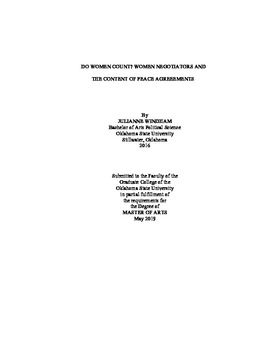| dc.contributor.advisor | Jalalzai, Farida | |
| dc.contributor.author | Windham, Julianne C. | |
| dc.date.accessioned | 2019-10-25T20:25:26Z | |
| dc.date.available | 2019-10-25T20:25:26Z | |
| dc.date.issued | 2019-05-01 | |
| dc.identifier.uri | https://hdl.handle.net/11244/321622 | |
| dc.description.abstract | International organizations, including the United Nations, have worked hard to brand gender equality as a tool for attaining long lasting peace (Bell and Rourke 2010). These efforts have persisted for decades, notably gaining traction with the passage of Security Resolution 1325 by the United Nations (Cohn 2008). Current studies on women and peace have found empirical evidence to support the argument that women's inclusion and consideration in peacebuilding leads to a greater likelihood of peace and a lasting agreement (Stone 2015; Krause, Krause, Branfors 2018). Scholarship argues that women are good for peace because women bring a greater emphasis to the needs of civilians and vulnerable groups (El-Bushra 2007; Radu and Badulescu 2017). This underlying causal mechanism for the relationship between women and sustainable peace is widely recognized, but has not been empirically tested in the literature (Paffenholz et al. 2018). In fact, qualitative research on women's involvement in peace negotiations asserts that women's ability to influence the process is heavily limited in most cases studied (Buchanan et al. 2012; Paffenholz et al. 2016). I evaluate the commonly accepted explanation for the positive effects women have on peace with the following research question, "How do women influence the content of peace agreements?" | |
| dc.description.abstract | I evaluate the relationship between numbers of women negotiators and the number of provisions on human rights and gendered interests. I examine the relationship between women and agreement provisions with a sample of 906 peace agreements from 32 individual peace processes over the course of twenty years (1990-2010), using a negative binomial regression analysis. I do not expect to find a strong correlation between women's presence in negotiation roles, defined as the number of women present at the negotiation, and the number of peace agreement provisions pertaining to human rights and women's rights. Rather than numbers, a major mediating factor is whether women have influence on the process, measured by the ability for women negotiators to speak, vote, and actively participate in decision-making discussions (Paffenholz et al. 2016). I conduct a qualitative analysis to demonstrate the applicability of my theory, using peace processes as illustrative examples of the mediating effects of influence on the relationship between women negotiators on women and peace. | |
| dc.format | application/pdf | |
| dc.language | en_US | |
| dc.rights | Copyright is held by the author who has granted the Oklahoma State University Library the non-exclusive right to share this material in its institutional repository. Contact Digital Library Services at lib-dls@okstate.edu or 405-744-9161 for the permission policy on the use, reproduction or distribution of this material. | |
| dc.title | Do Women Count? Women Negotiators and the Content of Peace Agreements | |
| dc.contributor.committeeMember | Rudloff, Peter | |
| dc.contributor.committeeMember | Herrick, Rebekah | |
| osu.filename | Windham_okstate_0664M_16124.pdf | |
| osu.accesstype | Open Access | |
| dc.type.genre | Thesis | |
| dc.type.material | Text | |
| thesis.degree.discipline | Political Science | |
| thesis.degree.grantor | Oklahoma State University | |
